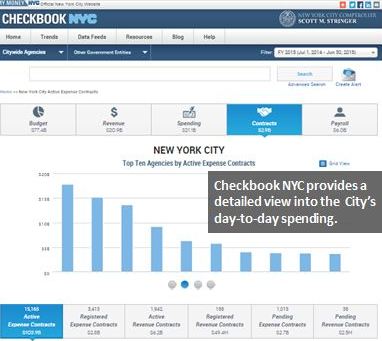The DATA Act Just Might Fulfill Jeffersonian Hopes For Transparency
 “[W]e might hope to see the finances of the Union as clear and intelligible as a merchant’s books, so that every member of Congress, and every man of any mind in the Union, should be able to comprehend them, to investigate abuses, and consequently to control them.”
“[W]e might hope to see the finances of the Union as clear and intelligible as a merchant’s books, so that every member of Congress, and every man of any mind in the Union, should be able to comprehend them, to investigate abuses, and consequently to control them.”
Thomas Jefferson to Treasury Secretary Albert Gallatin, 1 April 1802
Governments have made enormous progress in improving their transparency – thus increasing accountability. While the “union” is not quite there, implementation of the DATA Act with new standards for financial reporting and data publication will move the bar forward. In the meantime, local governments demonstrate numerous best practices. Thomas Jefferson would likely give a nod to many of the cities and states that have published checkbook-level details of their budgets.
Checkbook NYC Demonstrates Transparency
In July of 2010 the New York City Comptroller’s Office launched Checkbook NYC, an online transparency tool that for the first time placed the City’s day-to-day spending in the public domain. Using an intuitive dashboard approach that combines a series of graphs and user-friendly tables, Checkbook NYC provides up-to-date information about the City's financial condition.
In August 2014, the city’s Comptroller took the next step in online government transparency when he unveiled plans to provide vendor names, contract amounts and payments to prime vendors contracted to work on taxpayer-funded projects, along with new functionality including email alerts.
Checkbook NYC has been ranked the top transparency tool in the nation for tracking government spending by the United States Public Interest Research Group, and was named the “Best External Application” in 2013 by Government Technology Magazine.
DATA Act Drives Federal Transparency
The challenge of publishing checkbook level budget details is not insignificant. Just imagine that exercise scaled across the federal government. That’s the challenge the DATA Act brings to government agencies. Expanding the transparency of the Recovery Act, demonstrated by Recovery.gov and later absorbed into USASpending.gov, the DATA Act will require standardized reporting of all federal spending. Our report The DATA Act: One Small Step For Data, One (Potentially) Giant Step For Accountability provides an overview of the provisions and the timeline for implementation. In short, the law’s provisions include:
- Development of government-wide data standards and common elements.
- Establishing common formats for reporting the use of federal funds.
- Publication of all federal spending.
These are not simple tasks. Many agencies lack centralized financial systems and data maturity. The Department of Homeland Security – from its conception an aggregation of 22 departments – still has multiple financial systems, and only just recently got off the GAO high risk list. Financial system modernization is a top priority.
Fortunately, the timeline for implementation of the DATA Act spans four years, with milestones along the way:
- Year 1. In the first year, the Department of the Treasury and the OMB will define financial data standards for federal agencies and evaluate current reporting requirements for federal agencies and funding recipients.
- Year 2. In the second year, agencies will begin to adopt these standards, and a pilot program to test their impact on federal fund recipients and to establish adoption guidelines will start.
- Year 3. In the third year, agencies will themselves be held accountable for standards-based financial reporting with auditing of data completeness, timeliness, accuracy, and quality.
- Year 4. And by the fourth year, agencies will publish their standards-based financial data to USASpending.gov, and the OMB will announce final guidance for recipients.
But agencies should not stay in standards stand-by waiting for the common elements and reporting formats to be issued. There is plenty to do in the meantime. Agencies can take the time to:
- Address lack of data maturity and skills gaps
- Align processes to new reporting requirements
- Explore funding and resource impacts of the Act.
In order to make progress on these fronts agencies must:
- Be proactive and participate in the standardization process. A recent call for comments on common data elements generated 35 comments available for review on Github. Industry-sponsored DATA Act forums such as those sponsored by ACT-IAG bring agency leaders together to share best practice. Participating in these activities can familiarize agency leaders with the upcoming changes and the preparation of other agencies.
- Appoint a data (or DATA) advocate and a change advocate.This advocate could be from a number of departments: from finance, from IT, from management. The key to an effective DATA advocate is collaboration. The role requires working across the entire organization to understand the potential impact and to begin to anticipate change.
- Create a data readiness plan. The data advocate must bring together tech management and business stakeholders to craft the readiness plan: to inventory data needs, organizational and process gaps, and change management plans.
The task is monumental but coordinated efforts across the public and private sectors will help get there. And, just maybe, over 200 years later, Thomas Jefferson’s hope for financial transparency will come true.